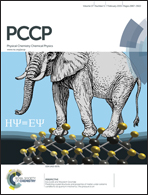Microsecond pulsed hydrogen/deuterium exchange of electrosprayed ubiquitin ions stored in a linear ion trap†
Abstract
A pulse of D2O vapour on the order of microseconds is allowed to react with the +6 to +9 charge states of ubiquitin confined in a linear ion trap (LIT). Two envelopes of peaks are detected for the ions of ubiquitin, corresponding to the ions that exchange more quickly and more slowly. The deuterium uptake of the protonated sites on ubiquitin ions accounts for the ion population with the fast exchange. The hydrogen/deuterium exchange (HDX) kinetics of ubiquitin ions trapped in the LIT for 200 ms showed comparable structural transitions to those trapped for 300 ms. When ions are trapped for longer, i.e. up to 2000 ms, mainly the slow exchanging ion population is detected. In all experiments the +7 ions exchange the most, suggesting a short distance between the surface protonated sites and nearby charged sites, and concomitantly high accessibility of surface protonated sites towards D2O. The +6 ions are more compact than the +7 ions but have one fewer protonated site, therefore fewer surface availabilities for D2O attack. The data suggest that the +6 ions keep most of their solution-phase contacts intact while the hydrophobic core is slightly interrupted in the +7 ions, possibly due to the exposure of charged His68 that is normally buried in the hydrophobic pocket. The +8 and +9 ions have more protonated sites but are less compact than the +7 ions because of Coulombic repulsion, resulting in a larger distance between the protonated sites and the basic sites. The data indicate that the HDX mechanism of ions with the slower exchange corresponding to the second envelope of peaks is primarily governed via a relay mechanism. The results suggest that the pulsed HDX MS method is sampling a population of ubiquitin ions with a similar backbone fold to the solution.


 Please wait while we load your content...
Please wait while we load your content...